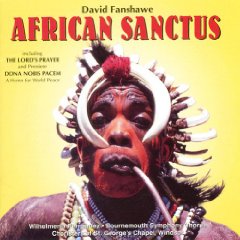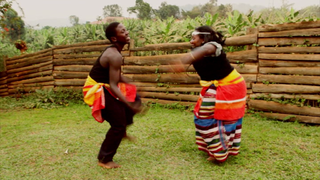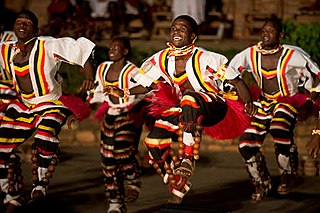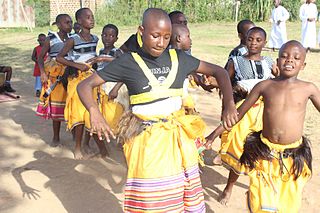
The traditional music of Tuvalu consists of dances, including fatele, fakanau and fakaseasea. The influence of the Samoan missionaries sent to Tuvalu by the London Missionary Society from the 1860s resulted in the suppression of songs about the traditional religions or magic and many songs were lost. As the influence of the missionaries diminished in the 20th century the traditional dances were revived and the siva dance tradition from Samoa also became popular.

Culture of Uganda is made up of a diverse range of ethnic groups. Lake Kyoga forms the northern boundary for the Bantu-speaking people, who dominate much of East, Central, and Southern Africa. In Uganda, they include the Baganda and several other tribes

The Iteso are a Nilotic ethnic group in eastern Uganda and western Kenya. Teso refers to the traditional homeland of the Iteso, and Ateso is their language.

In many parts of sub-Saharan Africa, the use of music is not limited to entertainment: it serves a purpose to the local community and helps in the conduct of daily routines. Traditional African music supplies appropriate music and dance for work and for religious ceremonies of birth, naming, rites of passage, marriage and funerals. The beats and sounds of the drum are used in communication as well as in cultural expression.

African Sanctus is a 1972 choral Mass and is the best-known work of British composer and collector of world musics David Fanshawe.
Jok is a term for a class of spirits in the traditional belief system of the Acholi people of Uganda and South Sudan. Jok are believed to be the cause of illness, misfortune, and death, as well as the source of power, protection, and prosperity. Traditional healers first identify the Jok in question and then make an appropriate sacrifice and ceremony to counter them. Alternatively if such an approach was unsuccessful the person possessed by the Jok could go through a series of rituals to gain some level of control over the Jok and then themselves become ajakwa. Jok can be ancestral or non-ancestral, and can be attached to specific clans, chiefdoms, natural phenomena, or historical events. Jok was believed to be the supreme god, who is the creator and ruler of the universe.

Bigwala is a genre of ceremonial music and dance of the Busoga Kingdom in Uganda centered around gourd trumpets.

The Acholi people are a Nilotic ethnic group of Luo peoples, found in Magwi County in South Sudan and Northern Uganda, including the districts of Agago, Amuru, Gulu, Kitgum, Nwoya, Lamwo, Pader and Omoro District. The Acholi were estimated to number 2.3 million people and over 45,000 more were living in South Sudan in 2000.

Larakaraka is a traditional courtship dance that originated from the Acholi people of Uganda. This dance, among the more than 50 Acholi dances, holds significant importance and is typically performed on special occasions, particularly weddings. Serving as a romantic display of artistry and physical prowess, Larakaraka enables young men to exhibit their dancing skills, vitality, and agility, all with the intention of attracting a potential life partner.
The Otole is a traditional war dance of the Acholi people. Its purpose is to teach young Acholi what to expect during combat. Participants include men and strong women aged 30-50 years.

Ekitaguriro aka Cow Dance is a traditional dance originating from Nkore or Ankole region which is located in the South Western Uganda. It is a celebratory dance that is performed by both men and women as an expression of gratitude for their cattle and to showcase local prosperity such as birth, marriage and abundant harvest. It is an integral part of social gatherings and events in the region, symbolizing the deep-rooted cultural significance of cattle in the community.

Entogoro, also known as Orunyege, is a traditional courtship dance that is performed by the Batooro people of western Uganda. The dance holds great significance in the Tooro culture, practiced by young adults to select potential partners for marriage, as well as during weddings, initiation ceremonies, and social gatherings. Its name comes from the ebinyege rattles and entogoro rings associated with the dance.
Ugandan folklore includes traditional folktales and other folklore from the African country of Uganda. The convey meaning and experiences from generation to generation. Traditionally, folktales instilled discipline and good behaviour that shaped societal beliefs and norms within Ugandan society.

Orunyege-Ntogoro is a traditional dance from the Bunyoro and Tooro kingdoms in western Uganda. It is a courtship dance that involves the use of rattles (ebinyege) and rings (entogoro) to produce rhythmic sounds and movements. The dance is performed by young men and women who seek to attract and impress potential partners for marriage.

Bakisimba dance (Baakisiimba) also known as Nankasa or Muwogola is a traditional dance form originating from the Baganda people of Buganda Kingdom in Central Uganda. It is believed to have originated from the movements of a drunken King Ssuuna of Buganda Kingdom. The dance was initially performed in the Buganda Royal Court in ancient times an it holds significant cultural and social importance within the community and is often performed during tribal ceremonies, celebrations, and festive occasions.

Dingi dingi dance, also known as Acholi Children's Dance, is a traditional dance originating from the Acholi people of northern Uganda who occupy districts such as Gulu, Kitgum, Lamwo, Pader, and Nwoya. The Acholi have passed down this cultural dance through generations. The name "dingi dingi" derives from the rhythmic sound produced by small drums played by skilled drummers.

Naleyo or Naleyo Dance is a traditional dance performed by the Karamajong people of North Eastern Uganda. It is a wooing dance performed in two lines with the women on one line and the men on the other line. The dance is characterized by the way the men and women jump high while facing each other, making it an interesting spectacle to watch.

Edonga Dance, also known as Edonga, is a traditional cultural dance originating from the Karamajong people, an ethnic group of the Nilotic community residing in the northeastern region of Uganda especially in Kotido and Moroto districts. This dance form is performed by both men and women, accompanied by melodious songs sung in the native Karamojong language. Edonga Dance holds significant cultural importance within the community and heritage of the Karamajong people.

Amaggunju is a traditional folk dance of the Baganda, who represent the largest ethnic community in Uganda. This royal dance is performed during important occasions such as coronations, weddings, and other cultural events. Notable features of the dance are its distinct rhythmic drumming and energetic movements, executed by both male and female performers.

Calabash is a traditional plant locally grown in many parts of Uganda. Its a non-food plant that produces several fruits of different sizes. The biological name of this plant is Lagenaria siceraria. Once harvested, its left to dry and is mainly used for traditional purpurses like dancing during traditional weddings, crafted as musical instruments by some tribes in their traditional dances for example the Bigwala, Baganda, Acholi, preserving milk, harvesting milk cream, and also used by traditional healers. Calabash is a symbolic cultural item that many Ugandan tribes use for different purposes.




















